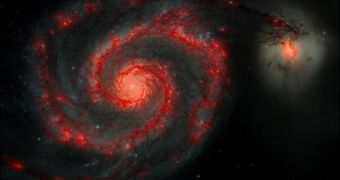Officials at the European Space Agency (ESA) have recently released an image of the Messier 51 galaxy, also known as the Messier Galaxy, which was partially collected by the newly launched Herschel Space Telescope, and partially by the famous Hubble Space Telescope. The composite photograph shows the well-known galaxy in unprecedented detail, and future collaborations such as this one could eventually give astronomers a lot more information about space structures than any individual telescope could.
The images composing the new picture are mostly taken in the visible and far-infrared wavelengths, and, for the first time, offer very clear insight into M51's stellar nurseries, the cool areas with a lot of dust and gas, where new stars are formed very rapidly. While astronomers had an idea as to where they might be located, the new image shows the locations directly, and they can easily be unidentified by the untrained eye.
“It's a wonderful image. It gives you some sense of the resolution we're going to get (with the Herschel telescope). The red areas are those we have detected where we know star formation is going on. We're seeing the birth of stars already,” the ESA Director of Science and Robotic Exploration, Professor David Southwood, said, quoted by the BBC News. He added that the image quality Herschel provided was well within expectations, but highlighted the fact that the observatory hadn't even been fully commissioned, as it was still undergoing tests and diagnostics, until managers would be convinced it functioned perfectly.
With a wavelength range spanning the infrared range from 55 to 672 microns, Herschel is the owner of the largest mirror ever to have flown in space aboard an infrared satellite. With it, the telescope can obtain the sharpest photos of given targets in its infrared spectrum. The target it had to photograph, Messier 51, is fairly close-by, only 35 million light-years away. Herschel's true tests lie ahead, when it will have to observe galaxies in the very early Universe, as closely to the Big Bang as possible.

 14 DAY TRIAL //
14 DAY TRIAL //